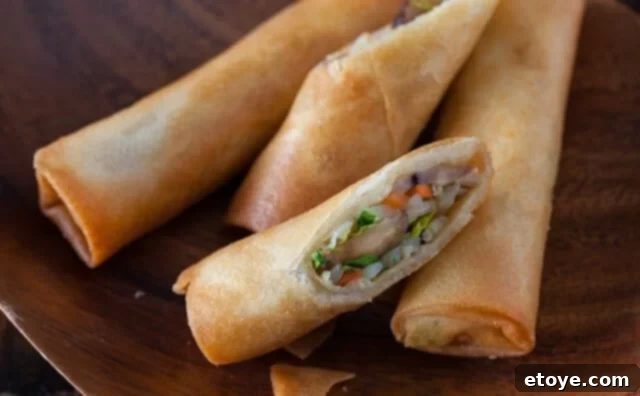Craving those irresistibly crispy, perfectly golden, and exquisitely flavorful vegetable spring rolls you adore from your favorite Asian markets and authentic Chinese eateries? Get ready to transform your culinary skills with this remarkable recipe, directly from my Chinese mother’s kitchen. These homemade spring rolls promise a light, shatteringly crisp exterior and a vibrant, non-greasy filling that will elevate your appetizer game. Beyond just ingredients, I’ve packed this guide with essential wrapping techniques and expert frying tips, including a step-by-step video, ensuring your very first batch of vegetable spring rolls turns out flawlessly. Prepare to master the art of rolling and frying with this authentic and easy-to-follow recipe for delicious vegetable spring rolls.
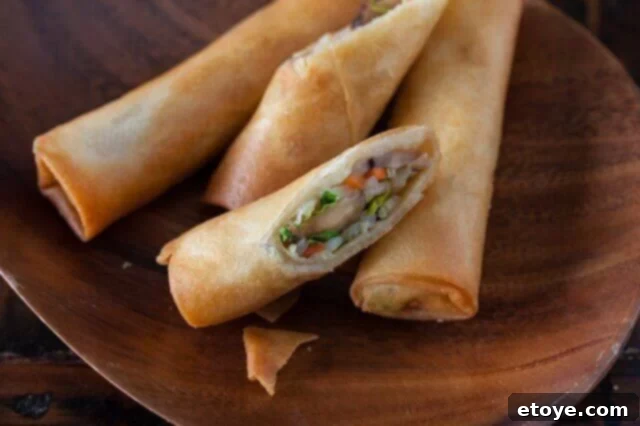
Why This Vegetable Spring Roll Recipe Stands Out
There are many spring roll recipes out there, but this one is a true family treasure, offering a taste and texture that consistently earns rave reviews. Here’s what makes these vegetable spring rolls truly exceptional:
- Achieve the Perfect Wrapper Texture: Bid farewell to thick, chewy, or overly bubbly wrappers that often absorb too much oil. This traditional spring roll recipe focuses on achieving that elusive, paper-thin, incredibly crispy shell. Each bite delivers a delightful crunch that shatters beautifully, a hallmark of expertly prepared Chinese spring rolls. It’s a delicate balance that ensures the wrapper enhances, rather than overpowers, the delicate filling.
- Unbeatable Crunch Factor: Our fried spring rolls aren’t just crispy on the outside; they boast a satisfying crunch within, thanks to a thoughtfully selected blend of fresh, crisp vegetables and aromatic herbs. You won’t find any soggy centers here! The combination of textures and flavors in every bite is truly fantastic, creating an addictive appetizer or snack that’s far superior to store-bought versions.
- Remarkably Light and Non-Greasy: Mastering the art of frying without resulting in an oily, heavy dish is key to a great spring roll. This recipe strikes that perfect balance, yielding vegetable spring rolls that feel surprisingly light and airy. You can enjoy several of these delightful bundles without any heavy feeling, making them an ideal appetizer for any occasion, from casual gatherings to festive celebrations.
- Effortlessly Freezer-Friendly: Whether you’re looking to meal prep for busy weeks or simply want to have a stash of delicious snacks on hand, these fresh spring rolls are your ideal solution. They freeze exceptionally well, maintaining their structural integrity and flavor. This means you can easily whip up a large batch, freeze the extras, and then deep-fry them straight from frozen whenever a craving strikes or unexpected guests arrive. Convenience meets authentic flavor!
Essential Ingredients for Authentic Vegetable Spring Rolls
Crafting perfect spring rolls starts with high-quality, fresh ingredients. Here’s what you’ll need for this vibrant vegetable filling:
- Cooking oil (for both stir-frying the filling and deep frying the rolls)
- Fresh aromatic staples: Ginger, garlic, and green onion
- Umami-rich shiitake mushrooms (fresh or dried and rehydrated)
- Crisp, fresh vegetables: Cabbage, carrots, bamboo shoots, and bean sprouts
- Flavor enhancers: Soy sauce and sesame oil
- Cornstarch (for thickening and sealing)
- High-quality spring roll wrappers (ensure they are thin for best results)
Each ingredient plays a crucial role. Shiitake mushrooms provide a deep, earthy umami flavor, while ginger and garlic add an aromatic base. The combination of cabbage, carrots, bamboo shoots, and bean sprouts ensures a delightful medley of textures and a fresh, crisp bite. Good quality spring roll wrappers are paramount for achieving that signature shatteringly crisp texture.
How To Make These Crispy Vegetable Spring Rolls – Step-by-Step Guide
Follow these detailed steps to create perfectly crispy and flavorful homemade vegetable spring rolls, just like my mom makes them:
- **Prepare the Aromatics and Initial Vegetables:** Begin by heating 1 tablespoon of cooking oil in a large sauté pan or a wok over medium-high heat. As soon as the pan is warm, add the finely minced garlic, grated fresh ginger, and chopped green onion. Stir-fry these aromatics frequently until fragrant, about 30 seconds. Once the oil is hot and fragrant, introduce the thinly julienned shiitake mushrooms, shredded cabbage, julienned carrots, and drained, julienned bamboo shoots.
- **Stir-Fry the Filling to Perfection:** Increase the heat to high and stir-fry the vegetables vigorously for approximately 2 minutes. This high-heat, quick stir-fry method helps to retain their crispness. Next, toss in the fresh bean sprouts, followed by the soy sauce and Asian sesame oil. Continue to cook for another minute, ensuring all ingredients are well combined and flavored. Immediately transfer the stir-fried vegetable filling onto a large baking sheet and spread it out in a single layer. To prevent any sogginess, gently prop one side of the baking sheet up so that any excess juices or oils accumulate at the bottom, which you should then discard. This crucial step ensures a dry filling, preventing your spring rolls from becoming greasy.
- **Prepare the Cornstarch Slurry:** In a small bowl, whisk together 1 tablespoon of cornstarch with 1/4 cup of cool water until a smooth, thin slurry forms. This mixture will act as a natural adhesive, ensuring your spring rolls are perfectly sealed and don’t unravel during frying.
- **Master the Art of Wrapping:** Lay a spring roll wrapper flat on a clean, dry surface, typically in a diamond shape with a corner pointing towards you. Place about 1 to 1.5 tablespoons of the cooled vegetable filling (do not overfill!) into the corner closest to you. Begin by tightly rolling the edge of the wrapper around the mixture. Once rolled once, fold the two side corners towards the middle, creating a neat envelope shape. Continue rolling tightly upwards. Before the final fold, paint the top edge of the wrapper with a small amount of the cornstarch slurry mixture. Finish rolling tightly, ensuring all edges are completely sealed. Place the finished spring roll seam-side down on a plate or tray and cover it with plastic wrap to prevent it from drying out while you prepare the remaining rolls.
- **Heat the Frying Oil:** In a large wok or a medium saucepan with deep sides, add about 1-2 inches of cooking oil. Heat the oil over high heat until it reaches approximately 350-375°F (175-190°C). If you don’t have a thermometer, a small piece of wrapper dropped into the oil should sizzle and float to the surface immediately.
- **Fry to Golden Perfection:** Carefully slide several of your wrapped spring rolls into the hot oil, ensuring not to overcrowd the pan, which can lower the oil temperature and lead to greasy rolls. Allow them to cook for 2-3 minutes, turning them over a couple of times with tongs to ensure even browning. Fry until the wrappers achieve a beautiful golden brown and crispy finish. Once cooked, remove the crispy spring rolls from the oil and transfer them to a cooling rack placed over a sheet of paper towels. This setup allows excess oil to drain away, maintaining their delightful crispness. Serve your homemade vegetable spring rolls hot and enjoy!
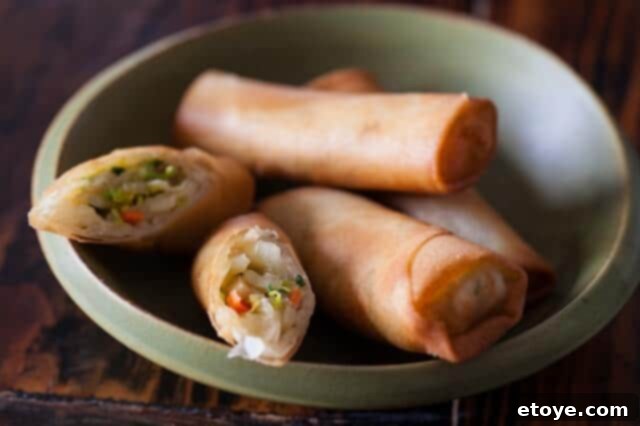
Unveiling Authentic Chinese Spring Rolls
This recipe is more than just food; it’s my Mom’s signature dish, a testament to authentic Chinese cooking. Real Chinese spring rolls, often distinguished from their thicker “egg roll” cousins, are characterized by their incredibly delicate, thin wrappers that fry up to a truly “shatteringly crisp” texture. The filling, unlike heavier versions, is light, subtly seasoned, and utterly addictive. It’s a harmonious blend that tantalizes the palate without overwhelming it.
Beyond being a delicious meal, spring rolls hold special cultural significance, particularly during Chinese New Year and the Spring Festival. Their golden, cylindrical shape is believed to resemble gold bars, symbolizing wealth and prosperity for the coming year. Sharing these delightful rolls with family and friends is a cherished tradition, bringing good fortune and deliciousness to the celebration. As you enjoy these, you’re not just eating a snack, but participating in a rich cultural tradition. You can learn more about other Chinese foods that bring wealth here.
Watch the Vegetable Spring Rolls Recipe Video (Including Wrapping Techniques)
To ensure your homemade spring rolls are perfectly wrapped and fried, I highly recommend watching the accompanying video. It provides a visual, step-by-step guide to the wrapping process, demonstrating exactly how to create tight, secure rolls that won’t fall apart or absorb too much oil during frying. Seeing the technique in action can make all the difference, especially for first-time spring roll makers!
The Authentic Chinese Dipping Sauce for Spring Rolls
When you order spring rolls at many Chinese-American restaurants, you might expect a side of sweet, sticky “duck sauce” or a vibrant “sweet chili sauce.” While these options are certainly popular and enjoyable, they are not traditionally served with authentic Chinese spring rolls in China.
The authentic way to savor the delicate flavors of a perfectly fried spring roll is with a few drops of Chinese black vinegar. Just a small drizzle down the middle of your roll is all you need! Chinese black vinegar has a distinct tartness and subtle sweetness that is remarkably similar to a good quality balsamic vinegar, albeit with its own unique depth. In fact, if you find yourself without Chinese black vinegar, a cheap, tart balsamic vinegar can serve as a surprisingly good substitute. Look for “Chinkiang Black Vinegar” or “Chinese Black Vinegar” at your local Asian market; it’s typically very affordable and a staple in any authentic Chinese pantry. This simple yet profound pairing truly highlights the delicate filling and crisp wrapper without overpowering them.
Can You Freeze These Homemade Vegetable Spring Rolls for Later?
Absolutely! These homemade spring rolls are excellent for freezing, making them a fantastic make-ahead appetizer or snack. Freezing them uncooked allows you to fry them fresh whenever you desire, providing maximum crispness and flavor. To ensure they freeze properly and don’t stick together, follow these simple steps:
After wrapping your spring rolls, arrange them in a single layer on a baking sheet lined with parchment paper. Place the baking sheet in the freezer and allow the rolls to freeze completely until solid. This “flash freezing” method prevents them from clumping together. Once frozen solid, transfer the individual rolls into a freezer-safe bag or airtight container. They can be stored in the freezer for up to 2-3 months.
When you’re ready to enjoy them, there’s no need to thaw! You can pop the frozen spring rolls directly into hot oil for frying. This method ensures they cook up beautifully crispy and maintain their shape, just like freshly made rolls. Adjust frying time slightly, adding an extra minute or two, to ensure they are heated through and golden brown.
Top Tips for Perfect Vegetable Spring Rolls Every Time
Achieving restaurant-quality spring rolls at home is easier than you think with these expert tips:
- **Ensure Dry Vegetable Filling:** After stir-frying, spread your cooked vegetable filling onto a large baking sheet. Crucially, prop one end of the baking sheet up slightly. This allows any residual juices and oils to drain away, preventing your filling from being watery or greasy. A dry filling is paramount for a crispy, non-soggy spring roll.
- **Opt for Thin Wrappers:** For that signature shatteringly crisp texture, the quality and thickness of your spring roll wrappers are vital. Ideally, use frozen wrappers, as they are often much thinner and more pliable than fresh, refrigerated ones. Thinner wrappers fry up crispier and less doughy, truly enhancing the overall experience.
- **Avoid Overfilling:** It’s tempting to pack your spring rolls with as much delicious filling as possible, but resist the urge! Overfilling is a common mistake that can lead to wrappers bursting during frying, releasing the filling and making a mess. Use approximately 1 to 1.5 tablespoons of filling per roll for optimal results.
- **Fry from Frozen (If Prepping Ahead):** If you’ve prepared a batch of spring rolls for later, you can place them directly into the hot fryer straight from the freezer. There’s no need to thaw them first. This method saves time and ensures a consistently crispy result, as the frozen state helps maintain their shape and prevents them from absorbing too much oil initially.
- **Maintain Oil Temperature:** Consistent oil temperature is key to perfectly fried spring rolls. Use a thermometer if possible, aiming for 350-375°F (175-190°C). If the oil is too cool, the rolls will absorb excess oil and become greasy. If it’s too hot, they will brown too quickly on the outside before the filling is heated through.
- **Don’t Overcrowd the Pan:** Fry spring rolls in batches. Overcrowding the wok or pan will significantly drop the oil temperature, leading to greasy and unevenly cooked rolls. Give each roll enough space to fry properly.
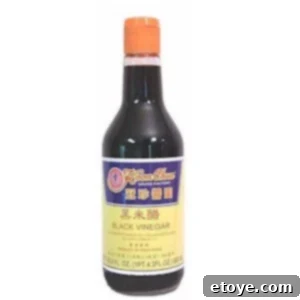
Frequently Asked Questions About Vegetable Spring Rolls
Here are some common questions to help you perfect your homemade vegetable spring rolls:
Can I use different vegetables in the spring roll filling? Absolutely! Vegetable spring rolls are incredibly versatile. Feel free to customize your filling with thinly sliced bell peppers, napa cabbage, mung bean noodles, or any other crunchy vegetables you have on hand. The most important tip is to cut all vegetables into thin, uniform strips or julienned pieces so they cook evenly and roll easily. Experimenting with different vegetables not only adds a variety of flavors and nutrients but also makes each batch of your homemade spring rolls uniquely yours.
What’s the best way to wrap spring rolls to ensure they don’t fall apart during frying? Proper wrapping is crucial for achieving perfect spring rolls that stay intact. Start by placing a modest amount of filling (about 1 to 1.5 tablespoons) in a corner of the wrapper closest to you. Fold that corner over the filling, then fold in the two side corners towards the middle, creating a neat, enclosed package. Continue to roll tightly upwards, ensuring there are no loose ends. Before the final roll, use a cornstarch slurry or a dab of water to seal the top edge firmly. A tight, secure roll prevents the filling from escaping and the wrapper from absorbing too much oil during deep frying. For a visual guide, be sure to watch my step-by-step video!
Can these spring rolls be made in an air fryer instead of deep frying for a healthier option? Yes, cooking spring rolls in an air fryer is a fantastic and healthier alternative to deep frying, significantly reducing the oil content while still achieving a delightful crispiness. To air fry, lightly brush or spray each spring roll with a thin layer of vegetable oil, ensuring even coating. Place them in a single layer in the air fryer basket, making sure not to overcrowd it. Cook at 390°F (200°C) for approximately 8-12 minutes, flipping them halfway through, until they are golden brown and crispy. Adjust cooking time based on your air fryer model and desired crispness.
What kind of dipping sauce pairs well with these vegetable spring rolls? A savory and flavorful dipping sauce can truly elevate your spring rolls. Beyond the authentic Chinese black vinegar, traditional options include sweet chili sauce, rich hoisin sauce, or a creamy homemade peanut sauce. For a more adventurous palate, consider a fish sauce-based dip with lime and chilies, or a simple yet elegant mixture of soy sauce with a dash of rice vinegar, a sprinkle of sesame seeds, and a touch of chopped green onion. The key is to select a sauce that complements the fresh, crispy nature of the spring rolls without overpowering their delicate flavors.
Is there a difference in texture or flavor between using rice paper wrappers and wheat flour wrappers? Yes, there is a significant difference in both texture and the type of spring roll they are traditionally used for. Rice paper wrappers, made from rice flour and water, are typically used for fresh spring rolls (also known as summer rolls). They become soft, translucent, and slightly chewy when rehydrated, and are not usually fried. Wheat flour wrappers, on the other hand, are the standard for fried spring rolls like these. They cook up to be wonderfully crispy, golden, and airy, providing that satisfying crunch that is characteristic of classic fried spring rolls. The choice of wrapper fundamentally dictates the final texture and culinary application of your rolls.
Can I make these spring rolls with rice noodles included in the filling? Certainly! Adding cooked rice noodles to the vegetable filling can provide an extra layer of texture and make the spring rolls more substantial and satisfying. If you choose to add them, ensure the rice noodles are cooked according to package directions, thoroughly drained, and cooled before incorporating them into the vegetable mix. They will absorb the delicious flavors of the other filling ingredients and contribute an enjoyable chewiness that complements the crisp vegetables perfectly. This can turn your spring rolls into a more filling snack or even a light meal.
What is the best oil for deep frying spring rolls? For deep frying spring rolls, choose an oil with a high smoke point and a neutral flavor. Excellent choices include canola oil, vegetable oil, peanut oil, or grapeseed oil. These oils can withstand the high temperatures required for frying without burning or imparting unwanted flavors, ensuring your spring rolls turn out golden and crispy with a clean taste.
Explore More Delicious Asian Recipes:
- My Mother’s Famous Chinese Egg Rolls Recipe
- Chinese Spring Rolls with Chicken Recipe
- Vietnamese Spring Rolls with Orange-Almond Sauce
- Vietnamese Spring Rolls with Slow Cooker Pork
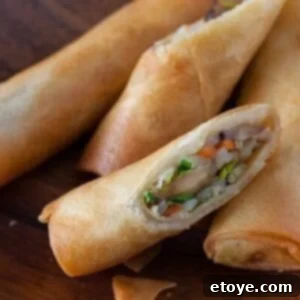
Crispy Vegetable Spring Rolls Recipe
Jaden’s Authentic Recipe
This recipe utilizes shiitake mushrooms, also known as Chinese black mushrooms, which can be found fresh or dried. If using DRIED shiitake mushrooms, you must rehydrate them first. Soak the dried mushrooms in a bowl of very hot water for about 30 minutes until soft. Once rehydrated, trim and discard the tough, thick stems before slicing them for the filling.
Pin Recipe
Ingredients
- 1 tablespoon cooking oil for stir-frying the filling
- 2 teaspoons fresh ginger finely grated with a microplane zester
- 2 cloves garlic finely minced
- 1 stalk green onion minced
- 8 shiitake mushroom caps fresh or rehydrated dried Chinese mushrooms, very thinly julienned
- 3 cups cabbage shredded (about 1/2 small head of cabbage)
- 1/2 cup julienned carrots (approximately 2 medium carrots)
- 4 ounces canned bamboo shoots drained and julienned
- 1 cup fresh bean sprouts
- 1 tablespoon soy sauce
- 1 teaspoon Asian sesame oil
- 1 tablespoon cornstarch
- 50 spring roll wrappers defrosted, preferably thin frozen wrappers
- cooking oil for deep frying (approximately 3 cups)
Instructions
- In a large saute pan or wok, swirl in 1 tablespoon of cooking oil. Turn the heat to medium-high and immediately add the minced garlic, grated ginger, and minced green onion. Stir-fry frequently until fragrant. Once the oil is hot, add the thinly julienned mushrooms, shredded cabbage, julienned carrots, and bamboo shoots.
- Increase the heat to high and stir-fry the vegetables for about 2 minutes to keep them crisp. Then, toss in the fresh bean sprouts. Add the soy sauce and Asian sesame oil, and cook for another minute, ensuring everything is well combined. Immediately spread the hot filling out onto a large baking sheet. Prop one side of the baking sheet up to allow any excess juices to accumulate at the bottom, and discard these juices to ensure a dry filling.
- In a small bowl, whisk together the cornstarch and 1/4 cup of cool water to form a smooth slurry. This will be used to seal the spring rolls.
- Place a spring roll wrapper on a flat surface in a diamond shape. Add about 1 tablespoon of the cooled vegetable mixture into the corner closest to you. Roll the wrapper edge tightly over the mixture. Fold the two side corners towards the middle of the wrapper, then continue to roll up tightly. Paint the top edge of the wrapper with a little bit of the cornstarch slurry mixture and wrap it tightly the rest of the way. Ensure all edges are securely sealed. Place the finished spring roll seam side down and cover with plastic wrap to prevent drying.
- In a large wok or medium saucepan, add about 1-2 inches of cooking oil. Heat the oil over high heat until it reaches 350-375°F (175-190°C).
- Carefully slide several spring rolls into the hot oil, ensuring not to overcrowd the pan. Allow them to cook for 2-3 minutes, turning them over a couple of times, or until the wrappers are beautifully golden brown and crispy. Remove the fried spring rolls to a cooling rack set over paper towels to drain excess oil. Serve hot with your favorite dipping sauce.
Nutrition Information (per roll)
My cookbook, “Steamy Kitchen’s Healthy Asian Favorites,” is available for purchase now wherever books are sold! Discover more delightful and authentic Asian recipes to cook at home. You can also pick up your copy conveniently on Amazon and embark on a delicious culinary journey.
